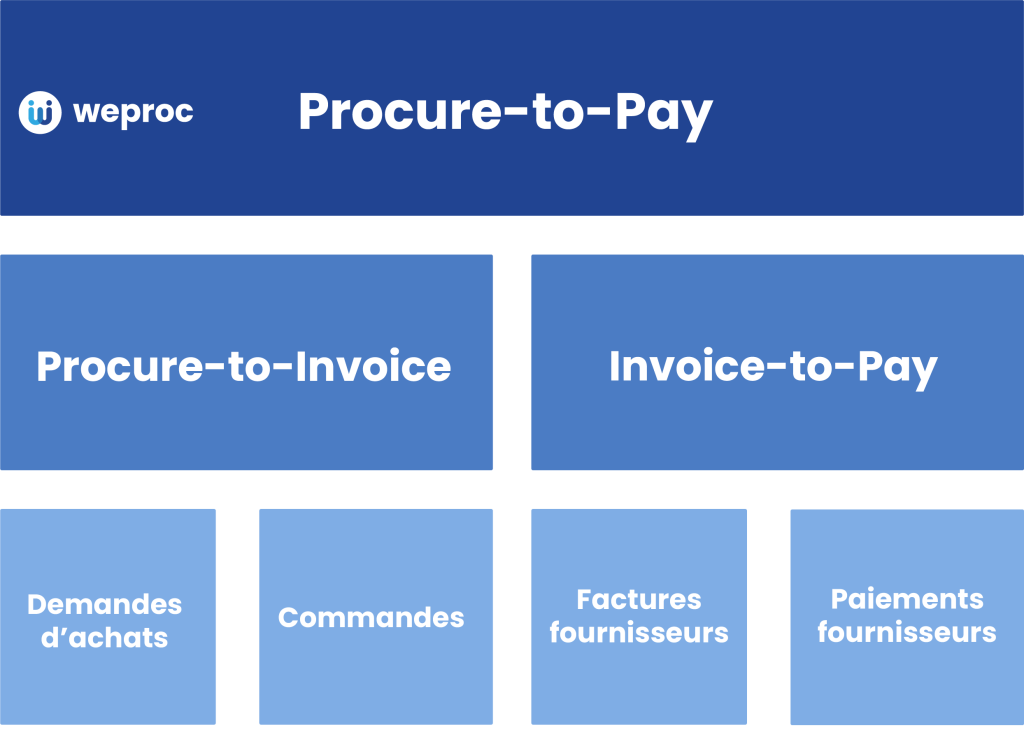What is source-to-pay (S2P)? How does it differ from Procure-to-Pay (P2P)?

S2P, P2P, S2C, I2P… these are all “barbaric ” terms for the uninitiated in the world of purchasing.
And even for the greatest experts, the sheer number of these terms can sometimes lead to confusion.
So let’s take a look at the “Source-to-Pay” process, which brings together a large number of these well-known purchasing processes.
First of all, you need to know that the best-known process is Procure-to-pay, literally “From order to payment”. But what is the difference between this distant cousin of S2P?
The Source-to-Pay process has more steps and starts earlier than the Procure-to-Pay process. Both processes share certain purchasing functions: order management, supplier invoice processing and supplier payment.
Sommaire
What is Source-to-Pay?
Source-to-Pay (S2P) is the sourcing and procurement process that consists of finding suppliers, negotiating with them and contracting with them to commit to a commercial relationship, thereby ordering products or services from them. Source-to-pay software uses the data it collects to give users greater visibility of their entire process and supplier relationships, with the aim of creating the most efficient procurement process possible.
What are the source-to-pay stages?
Source to Pay (S2P) is a process that leads to e-procurement, a term used to describe the management of online purchases.
The stages of Source to Pay :
- Purchase requisition
- Sourcing suppliers
- Preparing the invitation to tender
- Selecting the offer
- Contract management
- Signing the contract
- Sourcing
- Processing supplier invoices
- Payments

Source-to-Pay process diagram
Purchase request
The company must need a service or product. The demand may also result from the need to obtain a lower price or better conditions.
Sourcing suppliers
During this stage, potential suppliers who can meet the identified need are located and evaluated. This sourcing strategy can be carried out using software solutions that analyse data on the company’s spend, market trends and eSourcing objectives. Suppliers who meet the criteria set internally (and by the same token by the company’s purchasing policy) can now be invited to respond to the call for tenders.
Preparing the invitation to tender
The tender documents are drafted (with or without the help of the internal specifier, but it’s always better to be as close as possible to the customer’s needs), the suppliers’ responses are received and stored in a consultation management software programme. Tender documents may include requests for information (RFI), proposals (RFP) and quotations (RFQ).
Tender selection
During this fourth stage, the candidates must be examined. Some will be selected, others not. Depending on the type of purchase, and especially in the case of intellectual service(s), it is advisable to invite each of the shortlisted suppliers to attend oral juries. Each supplier will have the opportunity to present its offer in person (or by videoconference), in order to obtain more information.
Contract management
Now it’s time to add the selected suppliers to your supplier panel and negotiate prices and contract terms.
Once the contracts have been signed, they are kept for the duration of the contract’s life cycle, and then long enough to comply with tax and company document retention policies.
Contract signature
Once the terms of the contract have been finalised, it is time to complete the contract document and sign it. Once the contract has been signed, it’s time to hand over to the procurement team. The procure-to-pay process is an integral part of the source-to-pay process.
Procurement
The procurement team will be responsible for processing all purchase orders and requisitions and following up with suppliers.
Processing supplier invoices
The Accounts Payable department is responsible for entering and processing supplier invoices, including verifying the authenticity (and regularity) of suppliers, checking invoices, reconciling invoices received with purchase orders issued, and delivery notes.
Payments
The accounts department pays suppliers and reconciles payments to finalise the source-to-pay process, keeping suppliers informed of the progress of their payments.
How does the S2P system differ from the Procure to Pay system?
The S2P (Source to Pay) process is different from the Procure-to-Pay process because it starts earlier than the latter.
The S2P process includes specifying a need for products or services (purchase requisition), preparing invitations to tender, receiving and analysing supplier bids, negotiating and preparing the contract before awarding the contract, placing the order, receiving and reconciling the supplier invoice and purchase order, and of course, payment.
The Procure-to-Pay process only begins when the supplier order is placed. The requirement can be transmitted via a purchase requisition system, but this does not take into account the analysis of the prescribing requirement, the search for suppliers, the creation of a call for tenders, or the analysis of supplier offers. The P2P process continues in the accounts payable department, which processes suppliers’ invoices and makes payments to them.

Diagram of the Procure-to-Pay process
When does a company need a “source to pay” process?
When companies need to find new suppliers who offer better terms, lower prices or new products that current suppliers do not, the S2P (source to pay) process is essential.
The benefits of Source to Pay
There are many advantages to setting up a source-to-pay process:
- Consolidate the supply chain for greater efficiency
- Consolidate purchasing processes in one place
- Improving regulatory, procedural and contractual compliance
- Obtain more accurate and consistent forecasts
- Improve collaboration between suppliers and other business partners
- Analyse spend in more detail
- Assess suppliers against company benchmarks
- Price
- Quality
- Delivery times
- CSR..
What are the advantages of using S2P software?
Ultimately, companies that have the right tools will have a competitive advantage over other companies that do not use S2P software.

There are many advantages to using source-to-pay software:
- Real-time data analysis
- More competitive bids from potential suppliers
- Improved qualification and evaluation of suppliers
- Centralised tendering on one platform
- Long-term savings
- Process automation with streamlined workflow
- More accurate analysis of spend by supplier and by product or service category
- Reduced processing costs
- Simplified cash flow analysis
- Simplification of business processes
- Streamlined supply chain and spend management
- More effective risk management
- Easier to track and access supplier information
- Better overall user experience
Weproc, the French source-to-pay software
Companies can integrate supplier sourcing software, purchasing management software and accounting software with their ERP system so that they work together seamlessly as S2P (source-to-pay) solutions.
Weproc brings all these stages together in a single place: from issuing the requirement (purchase requisition), managing consultations (centralised calls for tender) through to placing the order, managing the supplier invoice and paying it, everything is managed directly in the software. You can also integrate Weproc directly with your ERP and accounting software.
Searching for suppliers, receiving supplier offers, negotiating, contracting, processing invoices and making payments no longer have to be laborious processes. S2P software makes it easier to manage suppliers efficiently and optimise business performance.
Accounts payable departments will find their tasks in the S2P cycle less tedious, more cost-effective and faster if they adopt source-to-pay software such as Weproc. This software eliminates manual, often paper-based, processes and can store supplier invoices by uploading them or scanning them using OCR to save time entering, processing and reconciling the information with the purchase orders issued.
Want to learn more about our procurement management software Weproc? Contact us or request your free 15-minutes demo below!

Weproc is a SaaS software specialized in digitizing the procurement process of companies. From purchase requests to supplier invoicing, through the validation process, Weproc is designed to simplify the purchase management of SMEs and mid-sized companies by centralizing all purchase-related activities.
